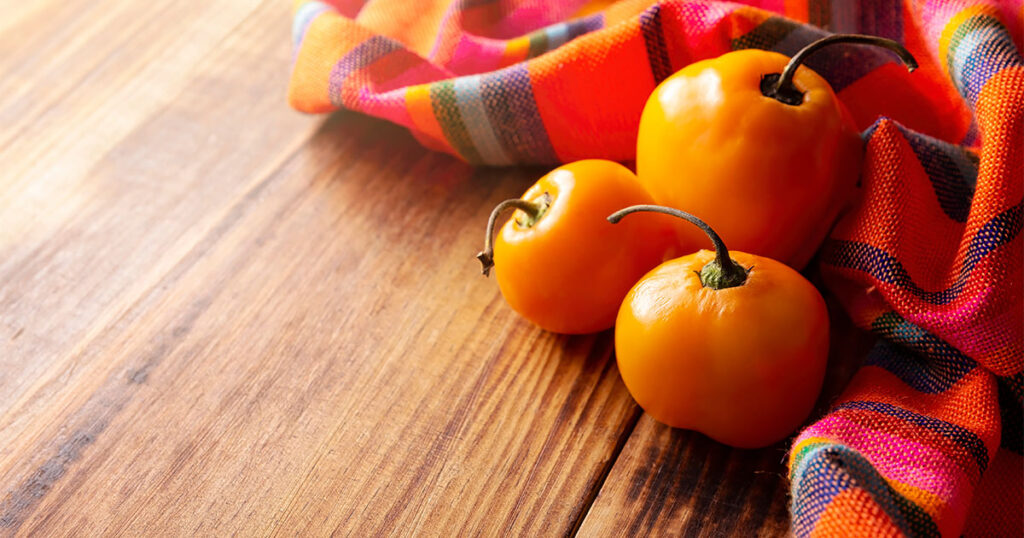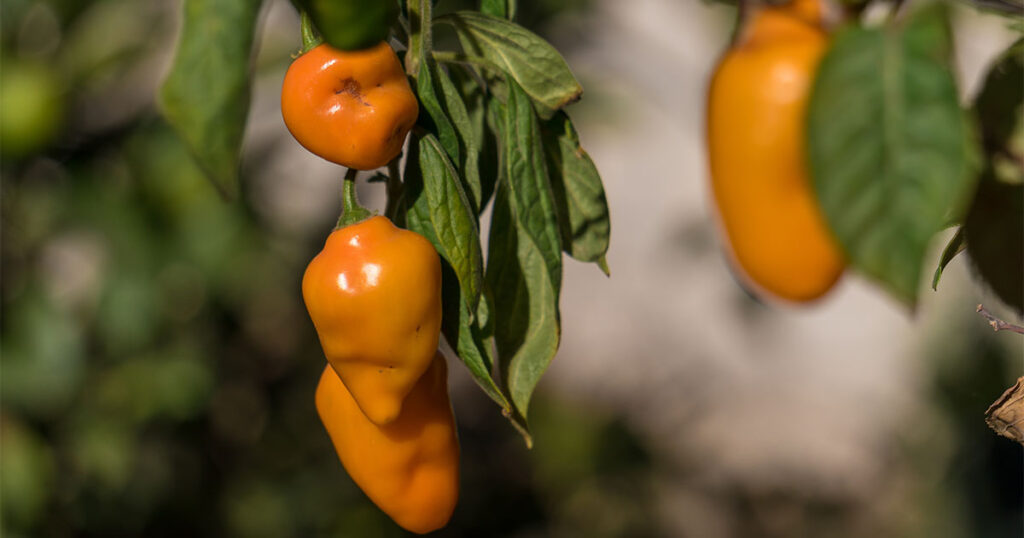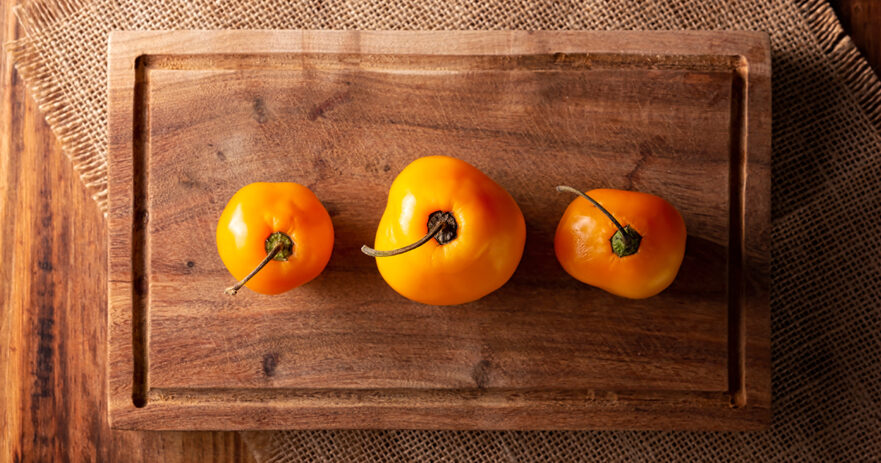In this article about manzano pepper:
🗺️ Origin and history | 🌶️ Uses | ✨ Appearance and taste | 🌶️ Types | 🧑🌾 Growing – gardening | 👨🍳 Cooking – recipes | 🛒 Where to buy | 🫙 How to store | 👨⚕️ Health benefits | 🌶️ Alternatives and substitutes | ❓ Frequently asked questions
What is the Manzano Pepper?
The Manzano pepper stands out as an intriguing chili variety, celebrated for its unique apple-like shape and a delightful blend of heat and fruity notes. Predominantly found in the mountainous regions of Mexico and South America, this pepper thrives in high-altitude areas, distinguishing itself from most chili varieties. Known for its thick, flesh-rich walls, the Manzano pepper offers a robust flavor, skillfully combining moderate heat with a refreshing, fruity undertone. This balance makes it a highly prized culinary gem in traditional and innovative recipes, appealing to various palates.
Gardeners and chefs treasure the Manzano for its versatility and unique contribution to gastronomy. Its resilience to cooler climates and ability to flourish in varied environments make it a favorite among garden enthusiasts. Its distinct flavor profile in the kitchen enhances myriad dishes, adding depth and complexity, from spicy salsas to savory sauces.
Are Manzano Peppers spicy? How hot are they?
Manzano pepper scoville: 12,000 to 30,000 SHU
Manzano peppers are known for their moderately spicy profile, creating a balance that combines heat with a distinct flavor. On the Scoville Heat Scale, they range from 12,000 to 30,000 units, positioning them between the milder jalapeños and the significantly hotter habaneros. This spice level renders the Manzano pepper highly adaptable in various culinary applications, providing a noticeable but manageable heat.
Its heat adds an exciting twist to dishes without overwhelming the palate. For those who appreciate a milder chili experience, Manzano peppers are a perfect choice. Their heat is intense enough to be felt, but it’s not as overpowering as some super-hot varieties. This makes Manzano peppers a versatile ingredient in various recipes, from salsas to sauces, offering a unique blend of heat and fruity undertones.
🗺️ ORIGIN AND HISTORY
Where does the Manzano pepper come from?
The Manzano pepper originates from the highlands of South America, particularly from the regions of Bolivia, Chile, and Peru. The name ‘Manzano,’ meaning ‘apple’ in Spanish, aptly describes the pepper’s apple-like shape. These regions, known for their high-altitude farming, provided the perfect conditions for the Manzano pepper to develop its unique characteristics.
Historically, the Manzano pepper has been a part of South American cuisine for centuries, with its introduction to Mexico occurring at the start of the 20th century.
In Mexico, the cooler weather in central regions proved ideal for cultivating Manzano peppers, leading to their widespread availability and popularity. The Manzano pepper’s adaptation to cooler climates is a notable trait, setting it apart from other chili varieties that typically require warmer temperatures.
🌶️ USES
What are Manzano Peppers good for? How to use them?
Manzano peppers are highly valued in the culinary world for their unique blend of moderate heat and fruity flavor, making them ideal for various dishes. Their citrusy, fruity taste and medium heat level are perfect for creating vibrant and refreshing Manzano pepper salsa. This salsa can be a delightful addition to various meals, enhancing flavors with its unique touch.
Moreover, these peppers are excellent for creating Manzano pepper hot sauce, where their distinct flavor profile really stands out. The hot sauce’s combination of heat and fruitiness adds a unique twist to many dishes, elevating their taste.
Additionally, Manzano peppers are great for pickling. Their thick walls and sturdy structure make them well-suited for being preserved in vinegar and spices, resulting in pickled Manzano peppers that serve as a delicious condiment or side dish, enhancing meals with an extra zing.
In their raw form, Manzano peppers are crisp and juicy, making them a delightful snack on their own or as a spicy addition to salads. They’re also fantastic when grilled or roasted, bringing out their natural sweetness and smoky flavor. Furthermore, their robust structure makes them perfect for stuffing with various fillings like meats, cheeses, or vegetables, offering a flavorful and spicy main course option.

✨ APPEARANCE AND TASTE
What does a Manzano Pepper look like?
The Manzano pepper is distinctive in appearance, resembling a small apple, which is fitting given its name. ‘Manzano’ means ‘apple’ in Spanish. These peppers are medium-sized, typically 1-2 inches long, and have a round, bulbous shape. When unripe, their color is a light green, which transitions to a vibrant yellow-orange or red upon ripening. A unique feature of Manzano peppers is their black seeds, which are uncommon among chili varieties. Their thick and juicy flesh differentiates them from the thinner-walled varieties commonly found.
What does Manzano Pepper taste like?
Manzano peppers offer a unique flavor profile, marked by a sweet, citrusy taste that sets them apart from other hot peppers. They have a medium heat level, ranging from 12,000 to 30,000 on the Scoville scale, making them hotter than a jalapeño but not as intense as some super-hot varieties. The sweetness and refreshing citrus flavor give them a richer and more flavorful experience than typical bell peppers. Manzano peppers are perfect for those who appreciate a spicy kick without overwhelming heat.
🌶️ TYPES
What are the different types of Manzano peppers?
Manzano peppers, known for their distinctive apple-like shape and robust flavor, come in various vibrant colors, each adding a unique taste and aesthetic to dishes. This section explores three notable types: red, yellow, and orange.v
Red Manzano peppers are notable for their deep red color, indicating full ripeness. They offer a combination of heat and a richer, slightly sweeter flavor than their less mature counterparts. Red Manzanos are excellent in salsas and hot sauces, where their vibrant color and robust taste can truly shine. They’re also popular for adding color and flavor to salads, grilled dishes, and stews.
Yellow Manzano peppers, with their bright, sunny hue, bring a slightly milder heat and a refreshing citrusy undertone. Their color results from partial ripening, making them a great middle ground between the green and fully ripe red varieties. These peppers are perfect for dishes where a balance of spice and subtle sweetness is desired, like stir-fries, salsas, and pickled preparations.
Orange Manzano peppers are a visually striking variety with a vibrant orange color. They strike a delightful balance between the red variety’s sweetness and the yellow’s tanginess. These peppers are fully ripe, offering a fruity and slightly spicy flavor that’s less intense than the red type but more pronounced than the yellow. They’re versatile in culinary use, adding color and a unique taste to dishes like sauces, salads, and grilled recipes.
Each type of Manzano pepper, whether red, yellow, or orange, brings its distinct flavor and aesthetic to the culinary world, making them a versatile and colorful addition to a wide range of dishes.
🧑🌾 GROWING – GARDENING

How to grow Manzano Peppers?
Manzano peppers offer a unique cultivation experience for home gardeners. Originating from the higher altitudes of South America, they are adapted to cooler conditions, contrasting with typical chili pepper preferences. Ideal for regions with cooler temperatures, typically between 45 to 60 degrees Fahrenheit, Manzano peppers flourish under full sunlight and can benefit from partial shade in hotter climates.
These peppers require well-drained, organically rich soil and balanced watering. They are notable for their longevity, often living many years and reaching significant heights in optimal conditions. Unlike other chili varieties, Manzano peppers have a higher tolerance to cold but must be shielded from frost. Hand pollination may enhance fruit setting, contributing to a successful and rewarding gardening venture.
When to pick Manzano Peppers?
Manzano peppers, cherished for their distinctive flavor and growth habits, typically reach maturity for harvesting within 80 to 100 days. Gardeners can identify their readiness for picking when the peppers transform from a light green to a rich yellow-orange or red, signaling full ripeness. The peppers, varying in size from small to apple-like, achieve a firm texture at maturity. This ripening period often occurs late in the summer and extends into the fall, influenced by specific climate conditions and growing practices. The timely harvest of Manzano peppers is key to enjoying their unique taste and culinary versatility.
👨🍳 COOKING – RECIPES
Cooking / Recipe ideas for Manzano Pepper
Manzano peppers, renowned for their distinctively fruity and citrusy flavor, are ideal for various culinary applications. Their medium heat level and sweet undertones make them excellent for vibrant salsas and flavorful hot sauces.
One popular use of Manzano peppers is in making Manzano pepper salsa. This salsa, known for its spicy yet flavor-rich profile, can be a great addition to dishes like chilaquiles, complemented with slices of avocado for an extra layer of flavor. The typical preparation involves roasting the peppers and tomatoes, blending them with ingredients like onions and garlic, and then simmering the mixture to achieve the desired consistency.
Manzano peppers are also perfect for creating a distinctive Manzano pepper hot sauce. A recipe might include sautéing the peppers with onions, seasoning them with sugar, salt, pepper, and Mexican oregano, and then adding stock and vinegar. After simmering, the mixture is cooled and pureed to form a hot sauce that can be used immediately or stored for later use.
Manzano peppers’ thick walls and robust flavor profile make them ideal for pickling, enhancing their appeal as a condiment or side dish. They are also perfect for stuffing, thanks to their ample size and thick walls, accommodating a variety of fillings from cheeses to meats, offering a balance of fruity heat and savory flavors.

🛒 WHERE TO BUY
Where can I buy Manzano Peppers?
Manzano peppers, notable for their fruity and citrusy flavor, can be sourced from specialty grocery stores, particularly those stocking diverse chili varieties. If unavailable locally, try exploring ethnic markets, farmer’s markets, or specialty food stores. For online options, several websites offer Manzano peppers in fresh form, along with various related products like sauces and snacks.
Where can I buy Manzano Pepper plants?
Gardening enthusiasts can find Manzano pepper plants at garden centers or nurseries specializing in vegetable plants. Online retailers also provide a convenient option to order these plants. When selecting Manzano pepper plants, looking for those with strong, healthy stems and lush, vibrant green leaves is important. Avoid plants showing signs of wilting, yellowing, or discoloration, as these may indicate poor health or stress. Choosing robust plants ensures a better start for growing at home.
Where can I buy Manzano Pepper seeds?
To start growing Manzano peppers at home, you can obtain seeds from local garden centers and online retailers. These options offer a convenient way to acquire Manzano pepper seeds for your home gardening projects. Once you have the seeds, follow the planting instructions carefully, providing sufficient sunlight and well-drained soil for the best growth results.
🫙 HOW TO STORE
How do I store Manzano Pepper?
To store Manzano peppers effectively, place them unwashed in a plastic bag or produce bag with small holes for airflow. A paper towel inside the bag absorbs excess moisture, keeping the peppers firm and preventing rot. Seal the bag partially to allow some air circulation. Alternatively, store your peppers in the refrigerator’s crisper drawer, adjusting the humidity settings to lower levels to prevent moisture build-up. When storing cut peppers, it’s best to use an airtight container or resealable bag and refrigerate them.
Can Manzano Peppers be frozen?
Yes. For freezing Manzano peppers, first, wash and pat them dry. If storing whole, simply freeze as is. For cut peppers, flash-freeze them on a rimmed baking sheet with parchment paper for about 3 hours before transferring them to airtight freezer bags or containers. They can be stored frozen for up to six months.
❤️🩹 HEALTH BENEFITS
Are Manzano Peppers healthy?
Manzano peppers are a nutritious addition to a balanced diet. They are rich in vitamins C and A, essential for a robust immune system, healthy skin, and overall eye health.
Manzano peppers also contain capsaicin, a compound known for its anti-inflammatory and pain-relieving properties, which may also contribute to improved metabolism and weight management.
However, individuals sensitive to spicy foods might experience gastrointestinal discomfort. In such cases, it’s advisable to moderate intake or avoid them to prevent adverse effects.
🔄 ALTERNATIVES AND SUBSTITUTES
What’s a suitable alternative to Manzano pepper?
Exploring alternatives to Manzano peppers unveils a spectrum of heat and flavor. The Habanero pepper stands out for those seeking a fiery punch. Its fruity undertone, similar to Manzano, is amplified by a scorching 100,000-350,000 Scoville heat units, making it a top choice for bold, spicy salsas and sauces.
The Serrano pepper is a commendable substitute for a milder yet flavorful option. A moderate heat of 10,000-23,000 Scoville units echoes the Manzano’s spiciness, fitting smoothly into various dishes like tacos and stir-fries. If you’re after a stronger kick, consider the Cayenne pepper, which intensifies the heat to 30,000-50,000 SHU, adding depth to soups, stews, and rubs.
In terms of sweetness and heat, the Scotch Bonnet pepper is notable. It mirrors the Manzano’s fruity taste but with a heat level on par with the Habanero, perfect for Caribbean dishes.
Lastly, the Fresno pepper, with its smoky sweetness and lower heat than the Manzano, is ideal for salsas, sauces, and grilling. Each substitute offers a unique twist, letting you tailor your cooking to achieve the perfect balance of flavor and heat.
How do you pronounce Manzano Peppers?
Manzano peppers are pronounced as mahn-ZAH-noh PEP-erz.”
🙋 FREQUENTLY ASKED QUESTIONS
FAQ about Manzano peppers
Is Manzano pepper hot?
Yes, Manzano peppers are considered moderately hot. They have a heat level ranging from 12,000 to 30,000 on the Scoville Heat Units (SHU) scale. This makes them spicier than jalapeños but less intense than many other hot chili varieties. Their heat is balanced with a unique fruity flavor, making them popular in various dishes.
Are Manzano peppers hotter than Habanero?
No, Manzano peppers are not hotter than Habanero peppers. While Manzanos have a heat level of 12,000 to 30,000 SHU, habaneros are significantly hotter, ranging from 100,000 to 350,000 SHU. This makes habaneros much more intense in terms of heat compared to Manzanos.
What’s the difference between a Manzano Pepper and a Scotch Bonnet?
What’s the difference between a Manzano Pepper and a Scotch Bonnet?The main differences between Manzano peppers and Scotch Bonnet peppers lie in their heat levels and flavor profiles. Manzano peppers have a medium heat level (12,000-30,000 SHU) and a sweet, fruity taste. In contrast, Scotch Bonnets are much hotter, reaching 100,000-350,000 SHU, and are known for their sweet, slightly tangy flavor, commonly used in Caribbean cuisine.
What’s the difference between Manzano pepper and Rocoto?
Manzano and Rocoto peppers are often confused due to their similarities, but they have distinct differences. Both belong to the Capsicum pubescens species and have thick flesh and black seeds. However, Rocoto peppers generally have a higher heat level, ranging from 30,000 to 100,000 SHU, compared to Manzano's 12,000-30,000 SHU. Rocotos also have a more variable shape and can be larger than Manzanos.

